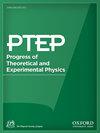Thermodynamic topology of topological black hole in F(R)-ModMax gravity’s rainbow
IF 8.3
4区 物理与天体物理
Q1 Physics and Astronomy
引用次数: 0
Abstract
In order to include the effect of high energy and topological parameters on black holes in F(R) gravity, we consider two corrections to this gravity: energy-dependent spacetime with different topological constants, and a nonlinear electrodynamics field. In other words, we combine F(R) gravity’s rainbow with ModMax nonlinear electrodynamics theory to see the effects of high energy and topological parameters on the physics of black holes. For this purpose, we first extract topological black hole solutions in F(R) -ModMax gravity’s rainbow. Then, by considering black holes as thermodynamic systems, we obtain thermodynamic quantities and check the first law of thermodynamics. The effect of the topological parameter on the Hawking temperature and the total mass of black holes is obvious. We also discuss the thermodynamic topology of topological black holes in F(R)-ModMax gravity’s rainbow using the off-shell free energy method. In this formalism, black holes are assumed to be equivalent to defects in their thermodynamic spaces. For our analysis, we consider two different types of thermodynamic ensembles. These are: fixed q ensemble and fixed φ ensemble. We take into account all the different types of curvature hypersurfaces that can be constructed in these black holes. The local and global topology of these black holes are studied by computing the topological charges at the defects in their thermodynamic spaces. Finally, in accordance with their topological charges, we classify the black holes into three topological classes with total winding numbers corresponding to −1, 0, and 1. We observe that the topological classes of these black holes are dependent on the value of the rainbow function, the sign of the scalar curvature, and the choice of ensembles.F(R)-ModMax 引力彩虹中拓扑黑洞的热力学拓扑结构
为了将高能量和拓扑参数对黑洞的影响纳入 F(R)引力,我们考虑了对这种引力的两种修正:具有不同拓扑常数的能量依赖时空和非线性电动力学场。换句话说,我们将 F(R)引力的彩虹与 ModMax 非线性电动力学理论结合起来,观察高能量和拓扑参数对黑洞物理的影响。为此,我们首先在 F(R) -ModMax 引力彩虹中提取拓扑黑洞解。然后,通过将黑洞视为热力学系统,我们得到了热力学量,并检验了热力学第一定律。拓扑参数对霍金温度和黑洞总质量的影响是显而易见的。我们还利用离壳自由能方法讨论了 F(R)-ModMax 引力彩虹中拓扑黑洞的热力学拓扑。在这种形式主义中,黑洞被假定等同于其热力学空间中的缺陷。在分析中,我们考虑了两种不同类型的热力学集合。它们是:固定 q 集合和固定 φ 集合。我们考虑了可以在这些黑洞中构建的所有不同类型的曲率超曲面。通过计算这些黑洞热力学空间缺陷处的拓扑电荷,研究了它们的局部和全局拓扑。最后,根据黑洞的拓扑电荷,我们将黑洞分为三个拓扑类别,总绕组数分别为-1、0 和 1。 我们发现,这些黑洞的拓扑类别取决于彩虹函数的值、标量曲率的符号以及集合的选择。
本文章由计算机程序翻译,如有差异,请以英文原文为准。
求助全文
约1分钟内获得全文
求助全文
来源期刊

Progress of Theoretical and Experimental Physics
PHYSICS, MULTIDISCIPLINARY-PHYSICS, PARTICLES & FIELDS
CiteScore
12.00
自引率
5.70%
发文量
148
审稿时长
17 weeks
期刊介绍:
Progress of Theoretical and Experimental Physics (PTEP) is an international journal that publishes articles on theoretical and experimental physics. PTEP is a fully open access, online-only journal published by the Physical Society of Japan.
PTEP is the successor to Progress of Theoretical Physics (PTP), which terminated in December 2012 and merged into PTEP in January 2013.
PTP was founded in 1946 by Hideki Yukawa, the first Japanese Nobel Laureate. PTEP, the successor journal to PTP, has a broader scope than that of PTP covering both theoretical and experimental physics.
PTEP mainly covers areas including particles and fields, nuclear physics, astrophysics and cosmology, beam physics and instrumentation, and general and mathematical physics.
 求助内容:
求助内容: 应助结果提醒方式:
应助结果提醒方式:


